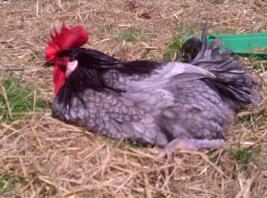Andalusisk høne


Andalusian History
This breed originates and takes its name from the Spanish province of Andalusia and is one of the oldest of the Mediterranean breeds.
They were imported to Britain in 1846 and were shown at the Great Exhibition of 1851. The blue colour comes from a hybrid cross between
the black and white varieties. When two blue birds are mated, 50% of hatchings will be blue while the remainder are black or white.
Gregor Mendel actually used this breed in his experiments into colour heredity. To be absolutely certain of getting blue offspring,
you need to cross a white cock with a black hen. The breed is usually referred to as the Blue Andalusian and was known at one time as the “Blue Minorca”.
They are very pretty birds, with light and dark blue plumage and an upright, elegant and graceful appearance. The hackle and saddle feathers are dark blue
while the breast is a lighter shade of blue. The feathers are laced which defines them beautifully while the tail, which is carried at 45°, and sickle
feathers are almost black. The face and wattles are red but they have white earlobes.
They have slate blue legs and toes and there is also a bantam version available.
Andalusian Behaviour
Andalusians are small, active birds which can be rather noisy and although they are still quieter than many of the Mediterranean breeds,
the noise factor may need consideration. The hens lay early at around 5 or 6 months of age but they don’t go broody often so aren’t natural sitters.
Chicks are hardy and mature early and they make excellent backyard birds although they can be rather flighty so make sure that your boundaries are sound and high!
They are calm birds and the males don’t usually fight with each other but they don’t like to be overcrowded so provide them with plenty of space to avoid problems
with bullying. They don’t really enjoy human contact and prefer free ranging to confinement as they are good foragers and economical feeders.
They are hardy but their combs can suffer from frostbite so care should be taken when temperatures plummet and exposure to a lot of sun can
fade their plumage so positioning their runs in the shade is a good idea. They are layers of large white eggs and will produce somewhere in
the region of 160 eggs per year,
continuing to lay during the winter months. Cocks weigh an average 7lbs while the hens are 5½lbs.
Andalusian Varieties
Blue, black and white
Billeder af Andalusian














Andalusian For Sale
Please note:
Alle dyr anført her er kun til afhentning. De kan ikke leveres af sælger eller af Omlet. Sælgeren sender dig deres kontaktoplysninger for at arrangere betaling og afhentning.
Sell Yours Here
det er gratis
Sorry, there are currently no Andalusian listed for Sale
Latest Reviews For Andalusian
There are not yet any reviews for this breed. Click here to write one.







